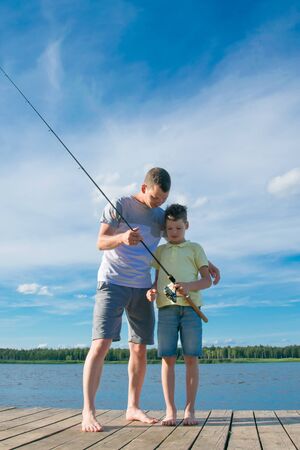Understanding Bass Behavior for Better Lure Selection
If you want to catch more bass, it all starts with understanding how they behave. Bass don’t just bite at anything — their activity changes based on the season, water temperature, and where they live. Knowing these patterns can help you choose the perfect lure at the perfect time.
Seasonal Bass Behavior
Bass act differently in spring, summer, fall, and winter. Here’s a quick breakdown to help you match your lures with their seasonal habits:
| Season | Bass Behavior | Best Lure Types |
|---|---|---|
| Spring (Pre-spawn & Spawn) | Bass move to shallow waters to spawn. Theyre aggressive and protective of nests. | Jigs, spinnerbaits, soft plastics like creature baits |
| Summer | Bass go deeper during hot days but feed actively during early morning and late evening. | Deep-diving crankbaits, topwater lures (early/late), Texas-rigged worms |
| Fall | Bass chase baitfish in shallow areas, stocking up for winter. | Lipless crankbaits, swimbaits, chatterbaits |
| Winter | Bass slow down and stay deep. They’re less active but still catchable. | Spoons, blade baits, finesse jigs |
The Role of Water Temperature
Water temperature is a big deal when it comes to bass activity. Heres how temps affect their mood — and what lures work best:
| Temperature (°F) | Bass Activity Level | Lure Suggestions |
|---|---|---|
| Below 50°F | Very slow and sluggish | Jigging spoons, small finesse jigs, drop shot rigs |
| 50–65°F | Increasingly active; spawning begins around 60°F | Soft plastics, jerkbaits, spinnerbaits near beds or cover |
| 65–75°F | High activity; aggressive feeding post-spawn | Crankbaits, buzzbaits, topwater frogs near vegetation |
| 75+°F | Active early/late; seek cooler, deeper spots midday | Deep cranks, Carolina rigs, shaky head worms in deeper structure |
Bass Habitat and Cover Preferences
Bass love structure — things like rocks, docks, weeds, and submerged timber. Where they hang out affects which lure will get their attention:
Docks and Shaded Structure:
Use skipping jigs or weightless stick baits to reach under overhangs.
Weed Beds and Grass Lines:
Try weedless frogs or Texas-rigged plastics that can slip through the cover without getting snagged.
Rocks and Ledges:
Craw-style jigs or crankbaits that bounce off rocks mimic natural prey.
Trees and Timber:
Punch rigs or flipping jigs are great for working heavy cover where bass ambush prey.
The more you understand about how bass behave throughout the year — and where they like to hide — the easier it becomes to pick the right lure for any situation. It’s not just about having a tackle box full of gear; it’s about using the right tool at the right time.
2. Topwater Lures: Creating Explosive Action
There’s nothing quite like the heart-pounding thrill of watching a bass explode on a topwater lure. These lures shine in the early morning or during low-light conditions when bass are actively feeding near the surface. Whether you’re casting into calm water at dawn or working a shady bank late in the day, topwater baits can be your go-to for exciting strikes and big catches.
Why Topwater Works
Bass are visual predators, and surface disturbances grab their attention fast. Topwater lures mimic injured baitfish or frogs struggling on the surface, triggering aggressive reaction strikes. The key is matching your technique with the right conditions and cover.
Must-Have Topwater Lures
| Lure Type | Best For | Top Picks |
|---|---|---|
| Walking Baits | Open water, calm conditions | Zara Spook, Heddon Super Spook Jr. |
| Poppers | Targeting structure like docks or laydowns | Rebel Pop-R, Rapala Skitter Pop |
| Frogs | Heavy vegetation and lily pads | Booyah Pad Crasher, Lunkerhunt Frog |
Walking-the-Dog Technique Made Easy
The walking-the-dog method gives your lure a side-to-side motion that drives bass crazy. To do this, use a slack-line twitching motion with your rod tip down. Keep a steady rhythm—think “tap-tap-pause”—and don’t rush it. This technique is best with walking baits in open water areas where bass can see the movement clearly.
Quick Tip:
If youre new to this technique, try using braided line for better control and responsiveness. It also helps keep your lure action tight and sharp.
Poppers: Small Splash, Big Reaction
Poppers create a short burst of noise and splash with each twitch of the rod tip. Theyre perfect for drawing out lurking bass from under cover like submerged logs or overhanging trees. Vary your cadence—try popping once, then pausing for a few seconds—to find what gets the most attention.
Tackle Tip:
A medium-action spinning rod with monofilament line works great for poppers because mono floats and adds to the natural action of the bait.
When to Use Which Topwater Lure?
| Condition | Lure Choice |
|---|---|
| Calm morning on open water | Zara Spook or other walking bait |
| Docks and submerged wood mid-morning | Popper like Rebel Pop-R |
| Midday thick mats or lily pads | Hollow-body frog such as Booyah Pad Crasher |
Using topwater lures isn’t just about throwing them out there—it’s about timing, location, and presentation. With these expert picks and techniques, you’ll be ready to create explosive action on your next bass fishing trip.
![]()
3. Crankbaits and Spinnerbaits: Covering Water Efficiently
When youre trying to locate active bass quickly, crankbaits and spinnerbaits are your best friends. These lures are designed to cover a lot of water in a short amount of time, making them perfect for searching across different depths and structures.
Why Crankbaits and Spinnerbaits Work
Bass are ambush predators that hang around structure—like rocks, submerged timber, docks, and weed lines. Crankbaits dive to specific depths and mimic baitfish with tight wobbling actions. Spinnerbaits create flash and vibration that trigger reaction strikes, especially in stained or murky water.
Crankbait Retrieval Tips
Crankbaits work best when retrieved with purpose. Here are some common techniques:
| Retrieval Style | Description | Best Used When |
|---|---|---|
| Steady Retrieve | Simple reel-in at consistent speed | Casting parallel to weed edges or rocky banks |
| Stop-and-Go | Pause during retrieve to mimic injured baitfish | Cold water or finicky bass days |
| Bounce Off Cover | Bump lure into rocks, stumps, or logs to trigger strikes | Around hard structure where bass are holding tight |
Spinnerbait Tactics for Different Conditions
Spinnerbaits shine when you need to call fish in with vibration and flash. Heres how to adjust them:
- Single Colorado Blade: Great for muddy water and low-light conditions due to strong vibration.
- Tandem Willow Blades: Better for clear water; offer flash without too much thump.
- SLOW ROLLING: Let the bait sink near bottom and retrieve slowly—works well in cold weather.
Choosing the Right Lure by Depth
| Lure Type | Diving Depth / Target Zone | Main Advantage |
|---|---|---|
| Lipless Crankbait | 1–6 ft (shallow flats) | Covers water fast, great for grass edges |
| SQ Bill Crankbait | 2–5 ft (around wood & rocks) | Bounces off cover well without snagging |
| Medium-Diving Crankbait | 6–12 ft (points & ledges) | Mimics mid-depth baitfish like shad or bluegill |
| Diving Spinnerbait | All depths depending on blade size & retrieve speed | Cuts through vegetation, great in wind or stained water |
Tournament Tip:
If you’re not getting bites within 15–20 casts, switch up colors or depth range. Bass behavior can change fast based on light, wind, or pressure—crankbaits and spinnerbaits let you adjust quickly on the fly.
4. Soft Plastics: Versatility at Its Finest
When it comes to bass fishing, soft plastics are a must-have in every angler’s tackle box. Their lifelike movement and wide range of styles make them one of the most versatile lure categories out there. Whether youre flipping into heavy cover or finessing in open water, theres a soft plastic bait that can get the job done.
Popular Soft Plastic Types
Let’s break down some of the most effective soft plastic lures for bass fishing:
| Type | Description | Best Use |
|---|---|---|
| Worms | Long, slender baits that imitate natural forage | Ideal for Texas or wacky rigging in clear or pressured waters |
| Creature Baits | Baits with multiple appendages for added action | Great for flipping and pitching into heavy cover |
| Stickbaits (Senko-style) | Straight-bodied baits that fall with a subtle wobble | Perfect for weightless wacky rigs around docks and vegetation |
Rigging Styles That Trigger More Bites
The way you rig your soft plastics can make all the difference. Here are two proven methods that consistently catch bass:
Texas Rig
This is a weedless setup where the hook is buried slightly into the plastic, making it perfect for fishing through grass, brush, and other cover. Pair it with a bullet weight to get down to where big bass hide.
Wacky Rig
This technique involves hooking the bait through the middle, allowing both ends to wiggle freely on the fall. It’s especially effective with stickbaits and works wonders in clear water and around structure like docks or submerged trees.
Pro Tip:
If youre not getting bites on one setup, switch things up. Sometimes just changing from a Texas rig to a wacky rig—or vice versa—can turn a slow day into an action-packed one.
5. Jigs and Trailers: Targeting Big Bass in Heavy Cover
If youre hunting for trophy bass, especially in thick cover like brush piles, laydowns, or rocky bottoms, jigs paired with the right trailer are a must-have in your tackle box. These lures mimic crawfish or baitfish and can be fished year-round, making them one of the most versatile and productive baits out there.
Why Jigs Work So Well
Jigs excel at getting into places other lures cant reach. Their weed guards help them slip through heavy cover without snagging, and when you pair them with the right soft plastic trailer, they look like a juicy meal to a hungry bass hiding nearby.
Mastering Jig Techniques
To really unlock the power of jigs, you need to master three key techniques:
Flipping
This short-range technique is perfect for precise presentations around stumps, docks, and vegetation. It lets you quietly drop your jig into tight spots where big bass love to ambush prey.
Pitching
A slightly longer cast than flipping, pitching allows you to target bass at a distance while still maintaining accuracy. Its ideal for working the edges of cover or probing deeper into brush piles.
Dragging
This slow and steady approach works great on rocky bottoms or ledges. Simply drag your jig along the bottom to mimic a crawfish scurrying away—an irresistible sight for any big bass nearby.
Picking the Right Trailer
The trailer you choose can make all the difference. Here’s a quick guide to help you pick the best one based on water conditions and fish behavior:
| Trailer Type | Best For | Action Style |
|---|---|---|
| Craw-style (e.g., Rage Craw) | Mimicking crawfish in warmer water | Lively kicking action |
| Chunk-style (e.g., Zoom Super Chunk) | Colder water or pressured fish | Subtle movement |
| Swimbait-style (e.g., Keitech Swing Impact) | Mimicking baitfish in open areas | Smooth swimming motion |
Tackle Tips for Jig Fishing
- Rod: Use a heavy power rod with fast action for solid hooksets.
- Line: Braided line (50-65 lb) is ideal for flipping and pitching; fluorocarbon (15-20 lb) works well when dragging jigs in clearer water.
- Knot: A Palomar knot gives strong holding power for heavy-duty jig work.
If you want to consistently land big bass, learning how to effectively fish jigs in heavy cover is a game changer. With practice and the right gear, you’ll be pulling giants out of places others overlook.


